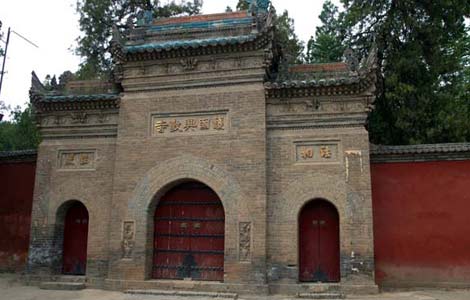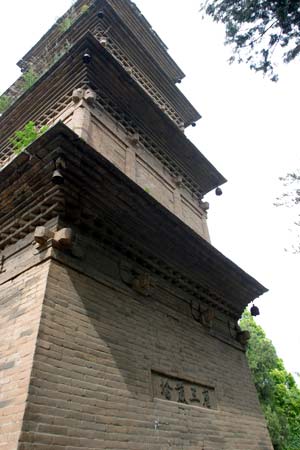Buddhist temple seeks to preserve on-site buildings
Updated: 2013-04-11 01:18
By Jin Haixing (China Daily)
|
|||||||||
|
 |
|
A gate of the Xingjiao Temple in Xi'an, Shaanxi province.Provided to China Daily |
Experts called for more discussions and consultations on protecting a famous Buddhist temple, which was asked by the local government to remove most of its buildings.
|
 |
|
The pagoda where the remains of Xuanzang, a prestigious Chinese Buddhist monk and traveler, was buried. Provided to China Daily |
Xingjiao Temple, in Duqu township in Chang'an district of Xi'an, Shaanxi province, is famous because the bone relics of a renowned Chinese Buddhist monk named Xuanzang were buried there.
The temple, with a history of 1,300 years, will apply for the World Heritage List with the pagoda, where the remains of Xuanzang are buried.
The temple received a notice from the local government to remove almost two-thirds of its buildings before the end of May. Wang, the head of the publicity department of Chang'an district in Xi'an, confirmed the news to China Daily on Wednesday.
A team that includes experts from city planning, cultural relics preservation and architecture had conducted detailed field research for the preservation plan of the temple, he said.
The removal will focus mainly on those buildings constructed by the monks themselves, which have little value for cultural preservation, he told China Daily.
However, monks of the temple expressed their concerns about the plans.
The monks said they support the program, but they do not want to remove so many buildings, which will affect their daily religious life because different sections of the temple have their own functions, according to a report in Nanfang Metropolis Daily.
"Actually, the different suggestions from the two sides reflect two conceptions in terms of cultural relic protection," said Pang Shouyong, a professor of Minzu University of China in Beijing.
Related readings:
Protection for unique culture and heritage
Tourism, cultural heritage to help boost soft power
Heritage being nursed back to health
Shanxi moves to preserve unique cultural heritage
Conservation of real heritage
China renews list of heritage candidates
China's intangible cultural heritages exhibit in Anhui
UNESCO reviews heritage protection
- Protection for unique culture and heritage
- Tourism, cultural heritage to help boost soft power
- Heritage being nursed back to health
- Shanxi moves to preserve unique cultural heritage
- Conservation of real heritage
- China renews list of heritage candidates
- China's intangible cultural heritages exhibit in Anhui
- UNESCO reviews heritage protection

 Li Na on Time cover, makes influential 100 list
Li Na on Time cover, makes influential 100 list
 FBI releases photos of 2 Boston bombings suspects
FBI releases photos of 2 Boston bombings suspects
 World's wackiest hairstyles
World's wackiest hairstyles
 Sandstorms strike Northwest China
Sandstorms strike Northwest China
 Never-seen photos of Madonna on display
Never-seen photos of Madonna on display
 H7N9 outbreak linked to waterfowl migration
H7N9 outbreak linked to waterfowl migration
 Dozens feared dead in Texas plant blast
Dozens feared dead in Texas plant blast
 Venezuelan court rules out manual votes counting
Venezuelan court rules out manual votes counting
Most Viewed
Editor's Picks

|

|

|

|

|

|
Today's Top News
Boston bombing suspect reported cornered on boat
7.0-magnitude quake hits Sichuan
Cross-talk artist helps to spread the word
'Green' awareness levels drop in Beijing
Palace Museum spruces up
First couple on Time's list of most influential
H7N9 flu transmission studied
Trading channels 'need to broaden'
US Weekly

|

|








